Archived Mold Remediation Blog Posts
Did You Know Summer Is Mold Season in Ocean County?
4/26/2024 (Permalink)
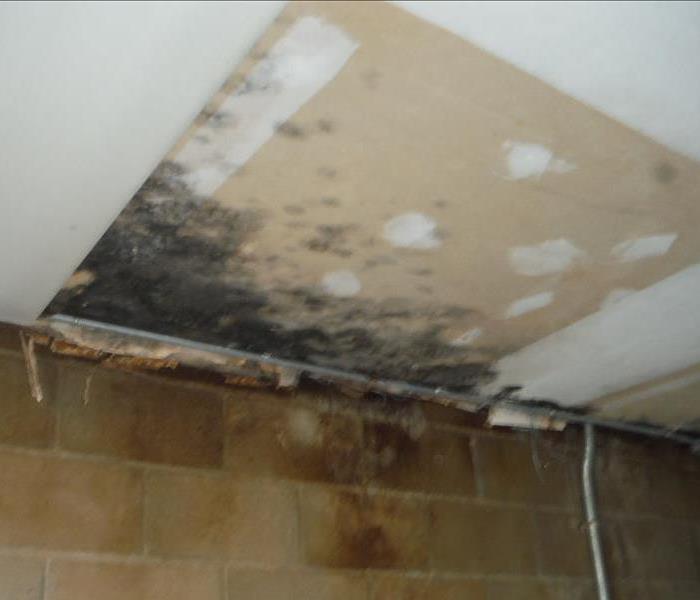 Drywall is porous (like a sponge) and all the little pores allow perfect breeding grounds for mold as shown here.
Drywall is porous (like a sponge) and all the little pores allow perfect breeding grounds for mold as shown here.
As we head into the summer and fall months, cases of mold growth will become more common. So much so, in the restoration industry, we refer to summer as "mold season", especially in Ocean County.
Here are some general proactive tips that can help mitigate the chance for mold growth:
- Engage in “moisture controlling” behaviors, such as fixing plumbing issues and other water problems as soon as they occur and drying the area completely.
- In bathrooms or other areas prone to a lot of moisture, consider running a fan, opening a window, or cleaning more frequently to minimize the chance for mold growth. Run exhaust and/or bathroom fans as appropriate, when showering. The goal is to increase ventilation and decrease dampness.
- If possible, keep the humidity of your property’s interior below 60%. The EPA recommends an ideal relative humidity percentage of 30% – 50%. You can measure relative humidity with a small device called a humidity or moisture meter.
- Condensation can be a sign of high humidity and may occur on walls, windows, pipes, or more. If you see condensation, act quickly to dry the surface, and if possible, stop or reduce the water source. Reduce humidity by using air conditioners and dehumidifiers.
- Repair roof gutters and make sure they are cleaned on a regular basis.
- Make sure appliances that use moisture ventilate to the outside, if possible.
- Be sure water pipes, or other cold surfaces, are covered with insulation if possible.
- Consider not using carpet in rooms or areas like bathrooms or basements that may have a lot of moisture.
- As part of routine maintenance, buildings should be checked regularly for evidence of water damage.
Mold is found both indoors and outdoors. Molds are part of the natural environment. Outdoors, molds play a part in nature by breaking down dead organic matter such as fallen leaves and dead trees but it can enter your home through open doorways, windows, vents, and heating and air conditioning systems. Mold in the air outside can also attach itself to clothing, shoes, and pets can and be carried indoors. It may begin growing indoors when mold spores land on surfaces and come in contact with moisture or water. It can grow especially well on paper products, cardboard, ceiling tiles, and wood products. Mold can also grow in dust, paints, wallpaper, insulation, drywall, carpet, fabric, and upholstery.
Mold growth, which often looks like spots, can be many different colors. Color is not an indication of how dangerous a mold may be. Any mold indoors should be removed and the moisture source that helped it grow should be removed. It is impossible to get rid of all mold and mold spores indoors. Some mold spores will be found floating through the air and in house dust but the mold spores will not grow if moisture is not present. Remember, moisture control is the key to mold control.
If you do find mold in your home or business, SERVPRO of Point Pleasant will be there. With the personalized care of local restoration professionals who live and work in Ocean County, we are dedicated to making any mold situation “Like it never even happened.”
Book Mold, Foxing or Age-Tanning?
3/23/2022 (Permalink)
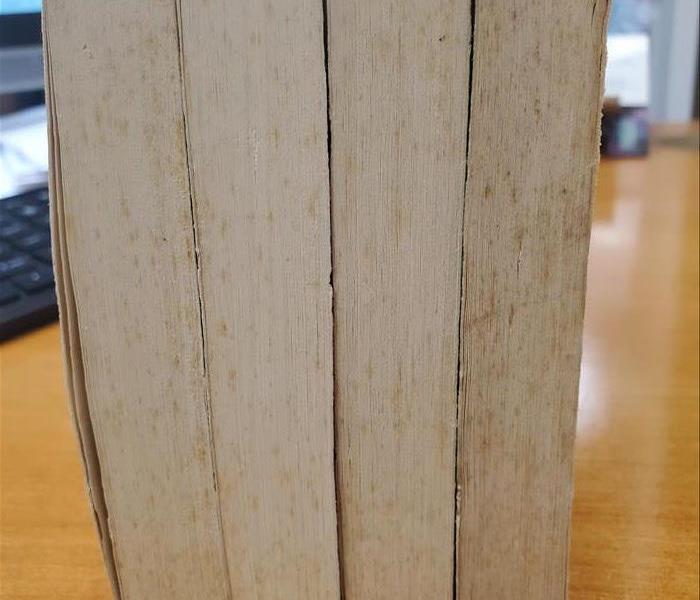 It is sometimes hard to distinguish between mold, foxing and age-tanning on books.
It is sometimes hard to distinguish between mold, foxing and age-tanning on books.
How should I store or pack my books to prevent mold?
If stored in a good environment, paper made in Europe from the late medieval period through to the mid-19th century tends to be in good condition. Paper made after the mid-19th century, however, may be affected by the poor quality materials from which it was made. From the mid-19th century onwards, increasing demand for reading material coincided with the development of mechanized papermaking and printing. This allowed the widespread use of cheap and plentiful wood pulp as the raw material for paper making. Wood pulp can simply be ground up and then made into paper. This type of pulp, known as groundwood, contains all the acidic components that are present in the wood. Paper made from groundwood pulp, e.g. newspaper, is cheap to produce but inherently very acidic, according to the Victoria and Albert Museum. The use of groundwood in old books can immediately be identified by the way the paper has turned a rusty-orangy-brown as the acids in it work away at the fibers, according to Rhollick.
Avoid storing books in attics, basements and garages and keep boxes slightly off the floor and away from the walls. This prevents damage from minor flooding and the airflow will help avoid insect damage and mold. For long term storage of valued books, individual, archive quality, boxes are a great option.
How often should I perform regular maintenance on my books?
Removing books from shelves once or twice a year to dust them will keep them clean and is a good way of noticing problems with mold or insects before too much damage is caused.
Besides mold, what else can cause yellow/brown/orange spots or browning on books?
- Age tanning, or browning, occurs over time on the pages of books. This kind of deterioration is commonly seen in books printed before the advent of acid-free paper in the 1980s, according to Biblio.com. Tanning tends to start from the outer edges of books and moves inwards over time, thus creating a yellowish or brownish border on the pages. This process can show up on just the edges of pages, when this occurs it is sometimes referred to as "edge tanning." The end papers of books are usually more acidic than the rest of the pages, so they undergo tanning faster. The process is more noticeable in the areas where glue has been applied to the back or where bookplates or newspaper cutouts have been kept says freelance writer, Satabdi Mukherjee. The browning of pages in older books will continue to be both part of the charm and challenge of book collecting.
- Foxing describes disfiguring small yellow brown spots or blotches on paper. Two main causes are mold and iron contaminants in the paper. Molds feed on the paper itself, as well as any dirt or organic material on it, for example, finger marks, food stains and squashed insects. Tiny metal impurities can be found in paper as a result of the original manufacturing process. Damp conditions will cause iron contaminants to rust. In some cases a conservator may be able to reduce the disfiguring effect of foxing, but in many cases you simply have to accept this old damage.
Is old-book smell always mold?
No. Explained best by Ann Elizabeth Wiener for the Science History Institute, that no one can deny that old books have their own distinct scent but that does not necessarily mean they have mold. Some love “old book smell’ while others despise it but everyone can agree that it is a potent, unmistakable smell but it can be a hard order to describe. That may be because no two books smell exactly the same. The complex scent is actually an amalgamation of specific chemical markers of decay that combine with how a book was made and how and where it was stored and used by the people who have touched it. In essence, when we breathe it in, we are simultaneously smelling the life and the death of a book. The paper, inks, and adhesives that make up a book contain hundreds of volatile organic compounds (VOCs). As these components break down, VOCs are released into the air, and we detect them in the form of that distinctive odor. (New books release their own, very different VOCs. Inks, solvents, adhesives, bleaching agents, and other chemicals involved in modern manufacturing processes combine to produce the crisp, synthetic smell you notice when you snap open a freshly printed text. Environmental factors, such as the kind of climate or room a book was stored in, whether it was dusty or dirty or exposed to constant sunlight or mildew, all contribute to a book’s smell profile. So to sum up, just because a book can smell like it’s past does not mean it has mold.
What may cause mold on my books?
Air carries moisture and paper is really good at absorbing water out of the air. Water rapidly escalates the deterioration of paper so humidity is extremely harmful to your books. Try to keep your books in a controlled humidity situation, according to BookWritten.com. Mold growth is caused by high relative humidity or dampness, combined with poor air circulation. Relative humidity measures the amount of moisture that is in the air relative to the maximum amount of moisture that the air could hold at that temperature. If conditions become dryer and relative humidity drops, the mold should become dormant, but will reactivate again if relative humidity rises. If you have mold on books, try to locate the source of the dampness and address the underlying cause of your problem.
What to do if you find mold in your books in your Brick Township home, study, office or library?
Call SERVPRO of Point Pleasant at 732-202-3001 today. We are trained mold damage specialists who get started quickly to get your home or business back to normal, with specific training and certifications to handle your restoration needs.
What Makes Mold Different Colors
2/11/2022 (Permalink)
 There are thousands of species of molds and each type of mold can vary in color, shape and size.
There are thousands of species of molds and each type of mold can vary in color, shape and size.
Mold is a type of fungus that forms multicellular, thread-like structures and produces spores that give it its color. Mold is typically green, white, black or grey but can be brown, purple, orange, pink, yellow, red, white, or even a combination of colors. The color of mold can be influenced by many factors including food source, humidity level, light, region and even their age. The same mold can be different colors in different conditions and can even change over time.
Mold is typically multi-colored. This is because most types of mold appear with a small array of color or colors, ranging from white at the edges to a dark or bright color in the center. The colors are the spores themselves, the second surrounding color is the body, and the white or gray are the filaments that explore and produce spores. It is important to remember that the same mold type can appear in several different colors. This can make it very difficult to identify any particular type of mold by appearance alone.
Here’s some interesting facts about different colors of molds:
- Blue Mold can start out as blue and if the area keeps getting wet, eventually it can start to eat the blue mold and it will become black or green. This is why blue will not always stay blue and is usually pretty powdery. Blue mold is often found growing on food, but it can also be found growing on household materials like wallpaper, insulation, furnishings and carpeting that have been damaged by water.
- Gray Mold affects many plant species and greatly depends on the type of plant and environmental conditions.
- Orange Mold is unique and generally not a single type of species, but more like a colony of single-celled organisms. This mold may grow together with some other mold types, such as green mold or black mold, especially on food and usually appears with a slimy, spongy consistency. It is typically spotted eating rotted trees that have fallen in the woods and in mulch piles.
- Purple Mold is something that you can find behind walls, often underneath vinyl and wallpaper, and on wood. It mostly grows in areas hidden from plain sight.
- Brown Mold typically grows on plywood, other wood surfaces and in the bathroom on window sills or between tiles. It may look like fuzzy growth or small moist blobs.
- Pink Mold is controversial as some believe it is not a mold but instead is a bacteria. Science has proven that it is indeed both a mold and a bacteria. It is mostly found in moisture-rich environments like bathrooms where it can feed off soap and shower products and tends to be fuzzy
- Red Mold usually grows in tandem with other color molds. It grows on building materials such as particle board or drywall. It can also grow on spoiled food.
- White Mold is the default spore-free color of most molds and the exploratory tendrils of a mold are almost always white before they produce and release spores. This means that very new mold will almost always appear to be white. It can be found on virtually any material and thrives in dark and damp areas that include framing in the attic, basement walls, and exposed dirt in crawlspaces.
- Green Mold appears as soft and fuzzy or powdery and can have different hues of green. It can basically grow anywhere in your home where a water problem may occur. It loves latching onto food such as bread and starch heavy foods.
- Yellow Mold is a common household mold and can found virtually everywhere you’ve experienced water damage. It is sometimes referred to as house-eating mold because it feeds on wooden structures and literally eats away at them causing the deterioration of many old wooden buildings and wooden furniture.
- Black Mold favors materials, such as cardboard, hay, paper, wicker, and wood especially in humid rooms of a house.
Interested in learning other fascinating science facts about mold? Try searching “prettiest molds”, “slime molds” and even “bizarre fruiting bodies of slime molds!” This shows just how amazing nature is in our world.
The only time it is not interesting to learn about mold is when you learn you have unwanted mold growing in your home or business. Regardless of the color of your mold, you want it gone as soon as possible. That is when it is time to call SERVPRO of Point Pleasant! Our highly trained technicians will remediate the mold with our Mold Remediation Process.
Do You Know How Molds Are Used In Our Daily Lives?
1/24/2022 (Permalink)
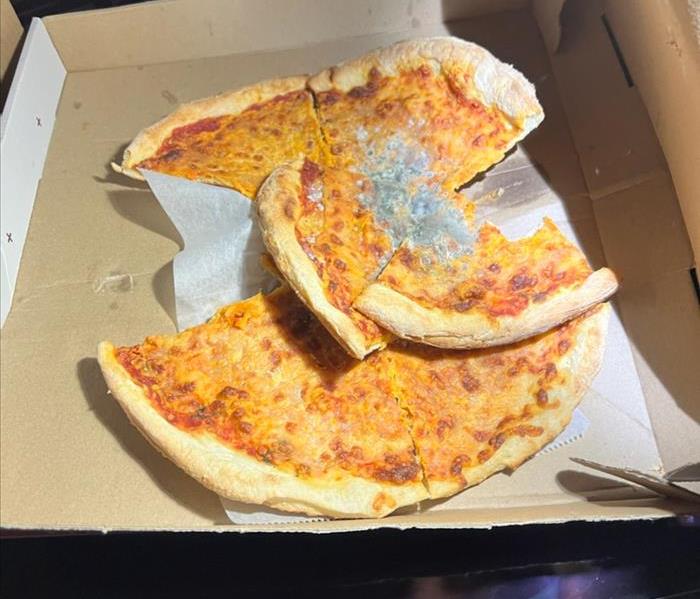 Not all molds should be growing on all cheese including this mold growing on old pizza from a hoarding situation in Manchester, NJ.
Not all molds should be growing on all cheese including this mold growing on old pizza from a hoarding situation in Manchester, NJ.
Mold is a scary word to some people but it is very common in our daily lives. Mold is a type of fungus that forms multicellular, thread-like structures. Mold is found everywhere in nature. Some molds are known to cause damage, decay and mild annoyances while others have become indispensable to humans.
Do you know what things are made from mold that most of us have used before?
- The Penicillium mold is one of the first and still one of the most widely used antibiotic agents to make Penicillin, Amoxicillin, Ampicillin and Nafcillin. The PBS News Story has an interesting article, The Real Story of Penicillin, about how Penicillin was first discovered to treat infections. It is truly remarkable how a few doctors changed the course of medicine that we still use in our lives today.
- The second thing made with mold that most of us use are certain kinds of cheeses. Yes, cheese. Blue veined cheese such as Roquefort, blue, Gorgonzola, and Stilton are created by the introduction of Penicillium roqueforti or Penicillium roqueforti spores. Cheeses such as Brie and Camembert have white surface molds. Production involves adding a white mold culture to the curd, causing a white bloom to grow on the surface. The cheese then ripens in four to nine weeks. The longer it is stored, the softer it becomes. Other cheeses have both an internal and a surface mold. The molds used to manufacture these cheeses are safe to eat. Visit Castello to look at some of their white mold cheese.
- Some molds are used in the production of alcohol. Rhizopus has several industrial applications in the manufacturing of enzymes and metabolites such as ethanol, lactic, and fumaric acids. This means that Rhizopus can metabolize starch into glucose, directly fermenting the glucose to give alcohol.
- Koji molds are used to ferment soybeans to make soy sauce. They are also used to make vinegar, as well as fermented beverages, like sake.
Mold can grow on almost all foods. Do you know what common foods are likely to grow mold?
- Fruits: Including strawberries, oranges, grapes, apples and raspberries
- Vegetables: Including tomatoes, bell peppers, cauliflower and carrots
- Bread: Especially when it contains no preservatives
- Cheese: Both soft and hard varieties
- Meats
- Nuts
- Milk
- Processed Foods
Even if mold is only visible on the surface, its roots may lie deep in the food.
What does mold need to grow on these foods?
Most molds need organic matter and oxygen to live, which is why they usually don’t thrive where oxygen is limited. Also, most molds need moisture to live.
Even though some molds are added to particular foods during production to achieve certain effects, the same molds can still spoil other products. Remember that just because some molds are used to make some cheese does not mean you should eat them.
So, how can you prevent mold from growing on your food?
According to healthline, here are their tips to help prevent mold growth in your food:
- Clean your fridge regularly: Wipe out the inside every few months.
- Keep cleaning supplies clean: This includes dishcloths, sponges and other cleaning utensils.
- Don’t let your produce rot: Fresh food has a limited shelf life. Buy a small amount at a time and use it within a few days.
- Keep perishable foods cool: Store foods with limited shelf lives, such as vegetables, in the refrigerator, and don’t leave them out for more than two hours.
- Storage containers should be clean and sealed: Use clean containers when storing food and cover it to prevent exposure to mold spores in the air.
- Use leftover food fast: Eat leftovers within three to four days.
- Freeze for longer-term storage: If you don’t plan on eating the food soon, put it in the freezer.
If you do find mold growing in places that should not have mold, call SERVPRO of Point Pleasant.
What is the Purpose of a Crawl Space and Why Mold is Common in Them?
3/3/2021 (Permalink)
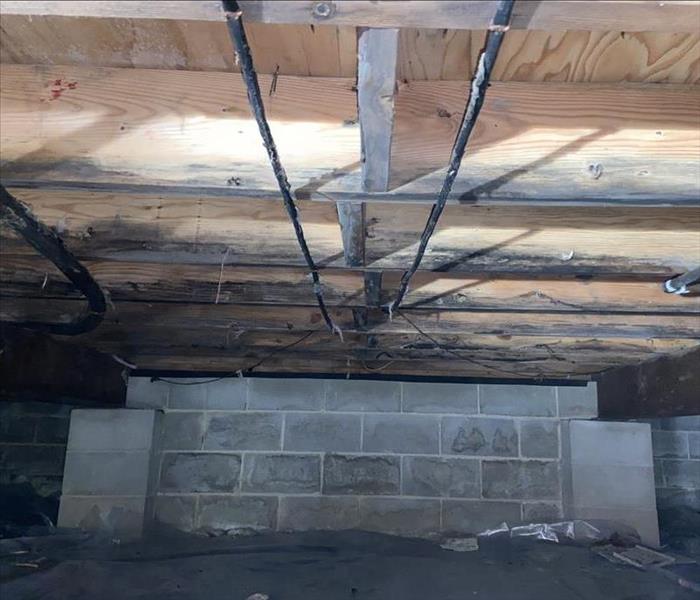 Mold in Point Pleasant crawl space on the wood before the mold clean up process begins.
Mold in Point Pleasant crawl space on the wood before the mold clean up process begins.
What is the Purpose of a Crawl Space?
A crawl space is essentially a hollow area under the floors of some homes between the ground and the first floor. Usually it is about 1 foot to 3 feet high, just high enough for someone to enter by crawling, as its name implies. Aside from elevating your home off the ground, a crawl space’s purpose is a convenient and inconspicuous place to contain stuff of the house that would normally be in a basement, such as its air conditioning and heater, duct work, insulation, plumbing, and electrical wiring according to Realtor.com.
Why Mold is Common in Crawl Spaces?
Wood, insulation and dirt floors all allow mold growth given the right circumstances such as moisture. A crawl space with excess moisture needs to properly vented or it may become a perfect breeding ground for mold. If there is a water issue of any kind and the source of the problem is not addressed, the crawl space is the perfect place for microorganisms like mold to multiply, according to Homelight.com.
If you find your crawl space has mold, you have 2 issues that need to be addressed:
- The cause of the mold
- The mold
SERVPRO of Point Pleasant has highly trained technicians that specialize in mold damage remediation. We arrive quickly to get your home back to normal, along with our specific training and certifications to handle your restoration needs:
- Applied Microbial Remediation Specialist
- Water Damage Restoration Technician
- Applied Structural Drying Technician
Have a mold emergency? Contact us at 732-202-3001.
It's Time to Winterize Your Summer Home
8/31/2019 (Permalink)
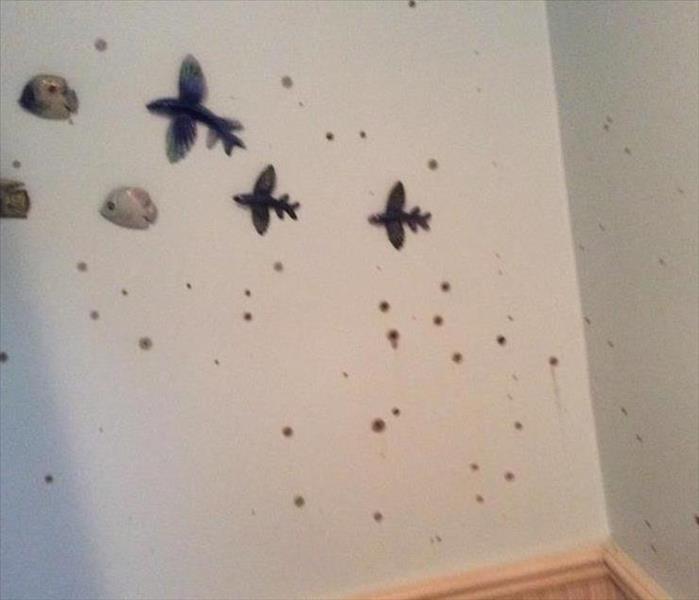 This Beach Haven home was left unchecked for a month and then was discovered to have both water and mold damage.
This Beach Haven home was left unchecked for a month and then was discovered to have both water and mold damage.
Even though the warmer weather might still be here for a little longer, the colder weather is just around the corner. Now is the time to start thinking about winterizing the water and plumbing systems in your summer home because a vacant house is particularly prone to damage during extended periods of freezing temperatures.
Proper care and frequent checks around your property by yourself if possible, or a friend, neighbor or relative while you are away, will help prevent your home from disaster. A quick look around done periodically for as long as the house is empty can mean the difference between a problem being caught early enough to be fixed before any damage is done, and a problem left unchecked left to cause serious and costly damage. The last thing you want to walk into after the long, winter season is to find a catastrophe has hit your vacation home.
Follow these simple steps to help prevent water and mold damage to your summer home:
- You may want to shut off the water to the house when you leave, as it reduces the chance of water leakage and subsequent damage. Always consult with your heating professional to determine if it is safe to turn off the water supply for your particular heating system. Also, if your home is protected by a fire sprinkler system, make sure that you do not turn off the water to this system. If you have turned off the water supply, drain your pipes of all water by opening the faucets, and flush your toilet to clear the water from the tank and bowl.
- If you decide against draining your water pipes, keep the furnace running with the temperature 55°F or higher to help ensure the home stays warm and that the pipes do not freeze. Also, wrap any pipes that might be exposed to the elements with insulation or heat tape. Keeping room and cabinet doors open can also help heat to circulate and warm the areas where pipes are located. Shut off the water to washing machine, dishwasher, and/or ice maker line where possible, to avoid leaks or broken hoses. It is also advisable to wrap insulation around the water heater, the pipes leading to and from it and insulate any pipes exposed outdoors, in a crawl space under the house, etc. If the pilot light is left on, it is not necessary to drain the water heater.
- Invest in smart home technology that detects water leaks and can alert you to a problem, before it overwhelms your house.
Even if you have someone regularly checking on your summer home, they might not see the water until it has caused serious damage to your property. Any home can quickly become infested with mold if a source of water is present. Mold can spread throughout a property in as little as 48 hours.
If you return to your summer home to water or mold damage or both, know that you will be in great hands if you call SERVPRO of Point Pleasant.
How to Defend Your Ocean County Home from Mold
2/20/2019 (Permalink)
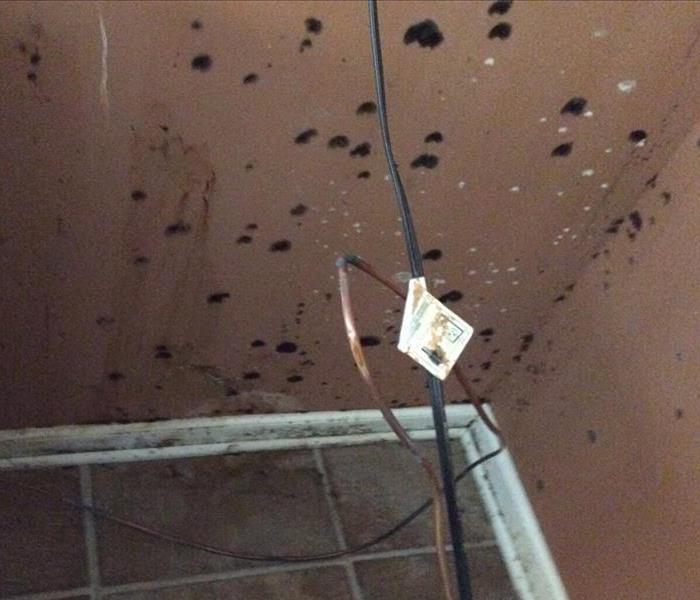 Leaky pipes left alone may not only bring water damage but mold damage too. Fix them ASAP to avoid mold growth in your Point Pleasant home.
Leaky pipes left alone may not only bring water damage but mold damage too. Fix them ASAP to avoid mold growth in your Point Pleasant home.
When there is a water or moisture intrusion of any kind in your home, mold can quickly become a problem. Not only can mold cause health effects but it can also cause significant damage to your property.
Follow these simple tips to help prevent your property against mold:
- Keep the humidity between 30-60 percent.
- Provide proper drainage away from your home’s foundation.
- Regularly inspect plumbing and appliances for leaks.
- Keeps gutters and drains free of debris.
- Inspect the roof, windows and other areas where water might enter the building and preform necessary maintenance.
- Respond to all water intrusions immediately.
- Contact SERVPRO of Point Pleasant ASAP if you suspect or find a water intrusion.
We understand both water, mold and mold growth. Our team has the training, protective gear and specialized equipment necessary to handle any mold problem. Because every mold damage is different and will require a unique solution, you need an experienced crew there to make it “Like it never even happened.”
Are You Aware that September is Mold Awareness Month?
9/1/2018 (Permalink)
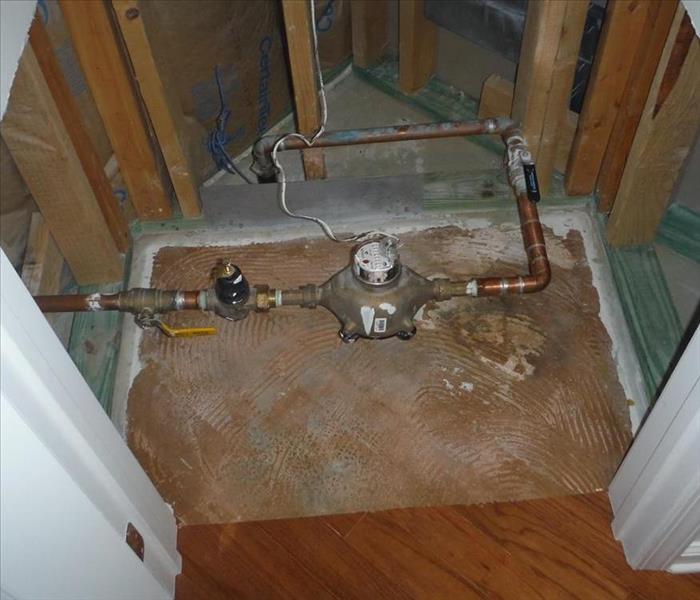 Mold spreads quickly, so a minor mold infestation can quickly escalate into a major problem.
Mold spreads quickly, so a minor mold infestation can quickly escalate into a major problem.
Are You Aware that September is Mold Awareness Month?
Molds are part of our natural environment, and can be found everywhere, indoors and outdoors. Molds are usually not a problem indoors, unless mold spores land on a wet or damp spot and begin growing. The mold spores will not grow if moisture is not present. Indoor mold growth can and should be prevented or controlled by controlling moisture indoors.
It only takes a small water leak, or even excess humidity, for mold to form in your Point Pleasant home or business. Then, mold can spread quickly through the property in as little as 48 hours. Mold can produce allergens and irritants, and it has the potential to cause other health effects.
Listed below are a few simple tips if you suspect you may have a mold situation:
- DO NOT ignore possible signs of mold. Immediately look for possible sources of moisture without disturbing suspected mold to prevent further spreading.
- Repair any sources of water as quickly as possible and thoroughly dry the any areas that are wet or damp.
- Move anything that is not suspected of having mold on it to a safe and dry area.
- If possible, seal off areas that may be contaminated to prevent further spreading.
If You See Signs of Mold,
Call SERVPRO of Point Pleasant Today at 732-202-3001.
Mold Spores are Present in the Air all the Time
7/5/2018 (Permalink)
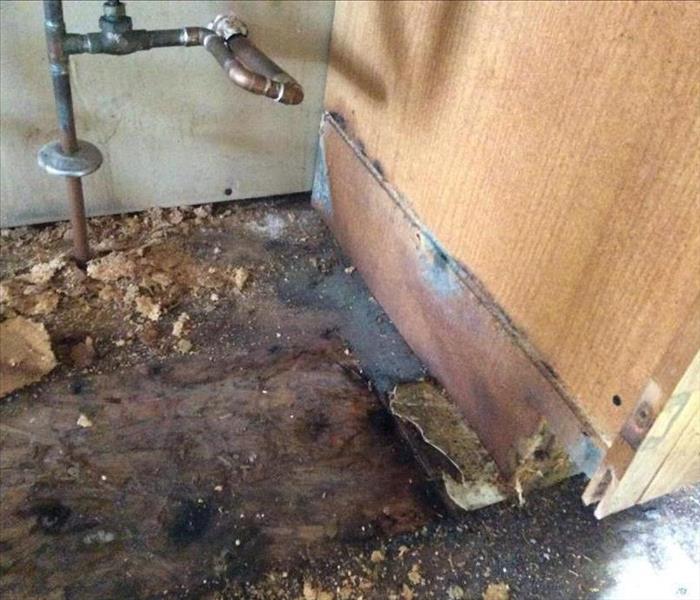 A water leak behind a sink was unseen for more than 48 hours and quickly spread into a "mold problem" in this home in Toms River, NJ.
A water leak behind a sink was unseen for more than 48 hours and quickly spread into a "mold problem" in this home in Toms River, NJ.
Mold spores are present in the air all the time so it is impossible to eliminate every trace of it. It becomes more a matter of preventing the start of mold growth rather than trying to eliminate it once it starts to grow and spread. You might come across “DIY” tricks for getting rid of mold, but they almost never work. The most effective option is usually to call a professional who can:
- Locate and identify mold
- Assess the damage
- Contain the mold and keep it from spreading
- Identify and repair sources of moisture
- Provide air filtration
- Physically remove the mold
- Clean the affected area
- Develop and execute a restoration plan
When choosing a mold removal company, it is important to remember that killing the mold is more important than scoring a low price or “cheap deal.” SERVPRO of Point Pleasant has highly trained specialists that specialize in mold removal and remediation. We effectively restore your home or business to pre-mold condition.
Mold can spread in as little as 48 hours. We will beat the clock and attend to your mold issue immediately so that it does not worsen. As your Point Pleasant neighbors, we take pride in making your mold problem “Like it never even happened.” If you suspect you might have a mold problem, call us 24/7 at 732-202-3001. You can also learn more about our mold remediation and restoration services here.
The Mold Remediation Process and Your Property
6/13/2018 (Permalink)
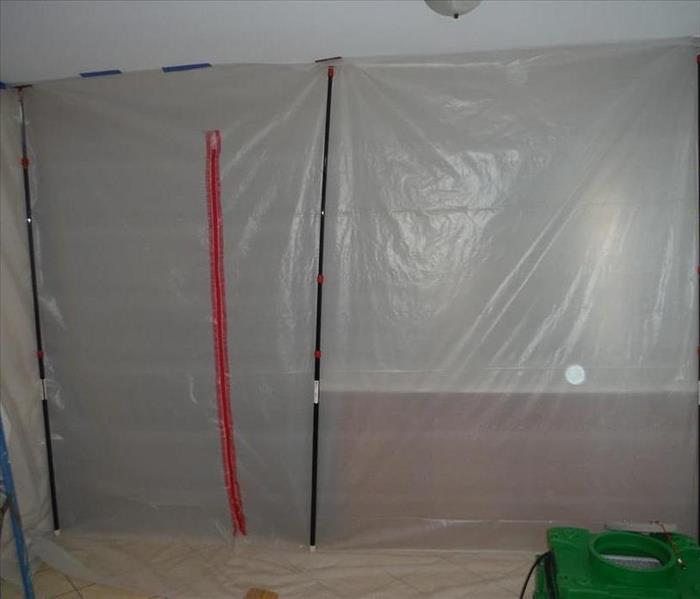 During our mold remediation process in this home in Brick, NJ, barriers were constructed to prevent the further spread of mold spores.
During our mold remediation process in this home in Brick, NJ, barriers were constructed to prevent the further spread of mold spores.
Molds are part of the natural environment. Outdoors, molds play a part in nature by breaking down dead organic matter such as fallen leaves and dead trees, but indoors, mold growth should be avoided, according to the EPA. Molds reproduce by means of tiny spores; the spores are invisible to the naked eye and float through outdoor and indoor air. Mold may begin growing indoors when mold spores land on surfaces that are wet or contain moisture. There are many types of mold, and none of them will grow without water or moisture.
Molds can gradually destroy the things they grow on. You can prevent damage to your home and furnishings, save money, and avoid potential health problems by controlling moisture and eliminating mold growth, according to the EPA.
Since microscopic mold spores exist naturally almost everywhere, indoors and outdoors, removing all mold from a home or business is impossible. Many restoration businesses advertise “mold removal” and even guarantee to remove all mold. This is a fallacy. We understand mold and mold growth. SERVPRO of Toms River has the training and expertise to remediate the mold in your home or business.
Every mold damage scenario is different and requires a unique solution, but the general mold remediation process stays the same. Learn more about our mold remediation process.
- Call SERVPRO of Point Pleasant as soon as possible at 732-202-3001
- Inspection and Mold Damage Assessment
- Mold Containment
- Air Filtration
- Removing Mold and Mold-Infested Materials
- Cleaning Contents and Belongings
For a guide from the EPA on Mold, Moisture and Your Home please visit their website.
A Water Intrusion Quickly Becomes a Mold Problem
3/12/2018 (Permalink)
 This home in Whiting, NJ had a roof that leaked into the attic, unbeknownst to the homeowners, and quickly turned into a mold problem.
This home in Whiting, NJ had a roof that leaked into the attic, unbeknownst to the homeowners, and quickly turned into a mold problem.
When there is a water intrusion, like a roof leak or leaking water line, mold can quickly become a problem in your home. Mold can cause health effects and significant damage to your property. Fortunately, the team at SERVPRO of Point PLeasant, has the training, protective gear, and specialized equipment necessary to handle your mold problem. Although every mold damage scenario is different requiring a unique solution, the general remediation process stays the same. The following steps illustrate a “typical” mold removal process:
- Call 732-202-3001 and we will ask you a series of questions to help us determine the necessary equipment, resources, and personnel needed for your mold problem.
- We will carefully inspect for signs of mold using technology designed to detect mold and hidden water sources, sometimes hidden from plain view.
- Containment procedures may need to be set up to further prevent spreading and isolate the contaminated area with physical barriers and negative air pressure to keep the mold spores from spreading during the cleanup process.
- Specialized filtration equipment will capture microscopic mold spores out of the air. We will utilize our powerful air scrubbers and HEPA vacuums to prevent the spread of these spores while the process is in progress.
- The remediation process depends on the amount of mold growth and the types of surfaces on which the mold appears. We will use antifungal and antimicrobial treatments to eliminate mold colonies and help prevent new ones from forming. Removing and disposing of mold-infested porous materials, like drywall and flooring, may be necessary to remediate heavy growth.
- Cleaning furniture, decorative items, curtains and other restorable items that are affected comes next. We use a variety of cleaning techniques to clean and sanitize your belongings along with removing odors and deodorization using fogging equipment.
- Finally, depending on the level of damage and removing what was necessary, installing new drywall, subfloors, carpeting, etc. and painting may be necessary to finish the restoration process
SERVPRO of Point Pleasant is a trusted leader in the restoration industry. Locally owned and operated, we live and work here and are proud to be part of this community. We are proud to provide mold remediation services in our local communities.
Mold is Present Almost Everywhere
3/2/2018 (Permalink)
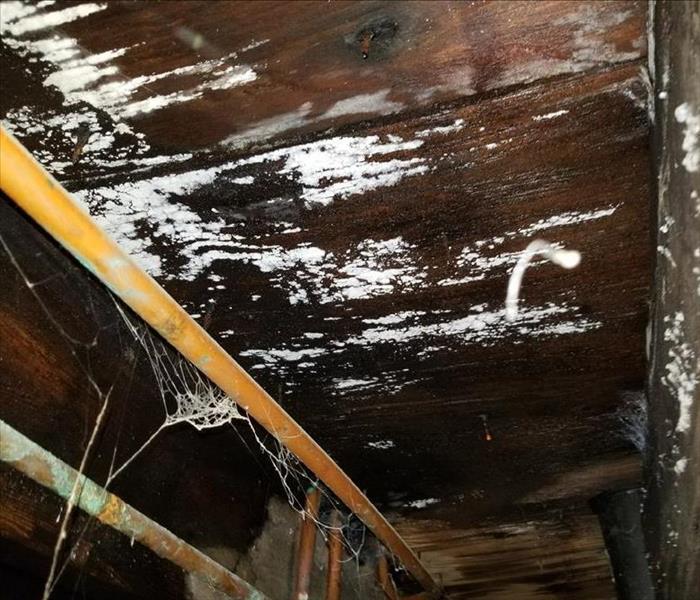 Mold growing on wood in a home in Tuckerton, NJ before the mold remediation process.
Mold growing on wood in a home in Tuckerton, NJ before the mold remediation process.
Mold is present almost everywhere, both indoors and outdoors, year round, which is not necessarily a bad thing. They are a necessary part of our environment that play a key role in the breakdown of organic materials and recycle nutrients back through our ecosystem.
Airborne mold spores float around inside our homes are simply a fact of our daily life and are normally not harmful. They only becomes harmful or bad when they enter our indoor environment and begin to grow on sustainable food sources that could potentially affect the air with an elevated level of mold spores.
Some examples of sustainable food sources are:
- Drywall
- Wood
- Carpeting or rugs
- Furniture
- Insulation
Indoors, mold needs moisture to grow and becomes a problem where there is water damage, elevated, prolonged or excessive humidity or dampness. They grow best in warm, damp, and humid conditions. Mold growth can start to grow on a damp surface within 24 to 48 hours and will digest organic material, eventually destroying the material they grow on.
Some people are unaware that molds can be many colors including white, green, orange or blue and not just black or grey. Color has no bearing on whether it is dangerous or not and not all black, brown, grey, or white spots are mold. When unsure, it is best to have a professional evaluate the situation.
The best practice is to remediate the mold at the source and work to prevent future growth. The key to preventing and stopping mold growth is to control excessive moisture and condensation. Removing the mold without fixing the water problem will usually result in the mold coming back. Keeping susceptible areas in the home clean and dry is critical. In cases dealing with humidity, use an air conditioner or a dehumidifier during humid months. Humidity levels change with changes in the moisture in the air and the air temperature, so they will need to regularly monitored. Be sure the home has adequate ventilation, including exhaust fans.
SERVPRO of Point Pleasant knows that every mold infestation is different, from the amount of mold to the types of materials affected. Each scenario requires a unique solution, but the general process stays the same. We are locally owned and operated, and proud to provide mold remediation services in our local communities.
If You See Signs of Mold,
Call us today at (732)349-9898.
Mold Removal: Get Rid of Mold for Good
1/27/2017 (Permalink)
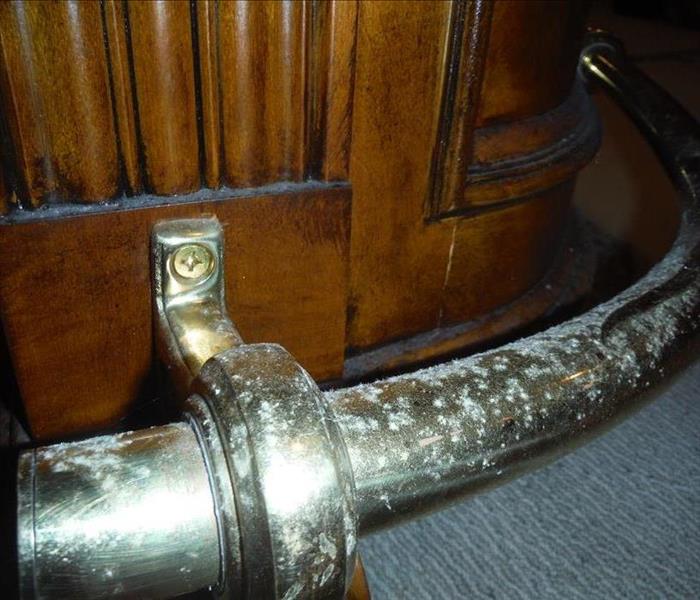 Mold remediation at home in Manahawkin, NJ by SERVPRO of Point Pleasant.
Mold remediation at home in Manahawkin, NJ by SERVPRO of Point Pleasant.
Mold Removal: Get Rid of Mold for Good
Mold is unhealthy and unrelenting. Cases of black mold are also unsightly, while other types of mold can be more difficult to detect.
It doesn’t take much for mold to become a big problem in your home or business, especially here in Point Pleasant, NJ, where humid summers, year-round precipitation and proximity to the ocean foster mold growth.
What Exactly is Mold?
Mold is a fungus that exists just about everywhere, indoors and outdoors. There are hundreds of thousands of mold types, ranging in seriousness from completely harmless to major health hazard. Microscopic mold spores float in the air, entering your home through windows, doors, AC/heating systems, and other small cracks that allow airflow. They can also live on your clothing and pets.
Why and Where Does Mold Grow?
When mold spores find a thriving environment, they can quickly multiply into allergen- and irritant-producing colonies. Mold typically grows when there is some combination of:
- Moisture (often from a leak)
- Humidity
- Warmth
- Darkness
- Oxygen
- Poor Ventilation
Mold also needs a food source, whether it’s drywall, fabric, wood, or any other material found in your home or business. If you are having ongoing respiratory problems, throat irritation, sneezing fits, or unexplained health concerns, you should check for mold in in the following areas:
- Under sinks
- Behind walls
- Around AC units
- Around windows
- Under carpeting
- In the basement
- In the laundry room
- Anywhere that might have been dampened
How Does Mold Removal or Mold Remediation Work?
Since mold spores are in the air all the time, it’s impossible to completely eliminate mold. It’s more a matter of keeping it out of your home or business. You might come across “DIY” tricks for getting rid of mold, but they almost never work. The most effective option is usually to call a professional who can:
- Locate and identify mold
- Assess the damage
- Contain the mold and keep it from spreading
- Identify and repair sources of moisture
- Provide air filtration
- Physically remove the mold
- Clean the affected area
- Develop and execute a restoration plan
Mold Removal Experts
When choosing a mold removal company, it’s important to remember that killing the mold is more important than scoring a low price or “cheap deal.” SERVPRO of Point Pleasant specializes in mold removal and mold remediation, with a team of highly trained mold damage specialists and an arsenal of advanced equipment to effectively restore your home or business the first time around.
Mold can spread in as little as 48 hours–we will beat the clock and attend to your mold issue immediately so that it doesn’t worsen. As your neighbors, getting rid of mold once and for all is as important to us as it is to you. If you think you might have a mold problem, call us at 732-202-3001, or request help online. You can also learn more about our mold remediation and restoration services here.





 24/7 Emergency Service
24/7 Emergency Service







